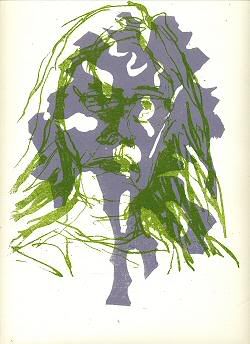Fresh Paint
Wednesday, March 24, 2004
Altered States
Every time I try to write this entry I find that I start writing something I don't mean, and then I realize I don't know much about art, or about how to write about it, either.
The show, Altered States: Printmaking after Modern Technology, both intrigued and disappointed me. I don't know what I had expected -- perhaps more prints. Maybe it's this: much of it seemed as though it was a lot of work to go through to produce a result that could have been gotten at in a more straightforward manner. Granted, traditional printmaking is above all a heavy process-oriented art, yet with several of the pieces, the end result of the printing was so covered up by other stuff that except for the label, you would never have known that a print was involved -- though I guess that was the point ("altered states", after all).
For example, Lenore D. Thomas layered her images (inkjet, I think) inside and underneath heavy translucent layers of wax on (I think) small pieces of plywood in vaguely geometric designs, sometimes with paint on the top layer that echoed something underneath (or maybe had nothing to do with it, in at least one case). Deborah Maris Lader produced small Polaroid transfer images of faces (onto metal? couldn't tell) which she then painted pretty much realistically, obscuring the original image completely. These were also small, and a little reminiscent of craft-fair folk-art paintings, perhaps intentionally.
The least print-like thing there was a beautiful old wooden chest of drawers, well used and polished that I kept tripping over while backing up and looking at stuff, until I realized it (by Stacey Stern) was part of the show, and since it had a sign on it that said, "Please interact with", I figured they didn't mean I should talk to it, but open the drawers. Yeah, so? A little print, or a phrase, or something in each drawer. But the chest of drawers was beautiful! I suddenly felt very stupid, since the images in the drawers were just so-so.
Therese Zemlin produced objects that were interesting and practical too, since they were (I hope they were, at least) wall lamps that showed a heritage to Japanese lanterns, but the paper was toner dyed, and inkjet images printed on Mylar (or whatever) could have (if the lights had been better hung) projected images onto a wall of mysterious and beautiful places. I don't usually like this kind of thing, but these (they were grouped somewhat organically) were pretty neat.
I generally like Carrie Iverson's work a great deal, and these were ok -- images printed on cloth or on paper mounted on wood and arranged accordion-like on the wall -- but to me what looked good and focused on paper, matted and framed, seemed a little too much like the designs on Pier One furniture throws when printed on fabric. So sue me.
Finally, the most traditional images there were produced by John Schulz, traditional in the sense of being actual archival inkjet prints on archival Rives paper whose heritage was color lithography or old-fashioned engravings. They showed their digitalness not just by being inkjet prints, but by using similar motifs Photoshopped throughout the series, which had a weirdly comic/serious narrative, and that now, days later, continues to float thru my brain. While some of the other pieces in the show seemed to be more like, "Yeah, I get it. Printed pieces of paper that say 'I'm too...' attached to a dressmaker's dummy," I wish I had not succumbed to their gimmickry and looked at these longer.
But the show is up until April 13 at the Suburban Fine Arts Center in Highland Park, IL, so I can always go back. It is a nice show, and I'm just being a bitch.
 This work is licensed under a Creative Commons License.
This work is licensed under a Creative Commons License.








